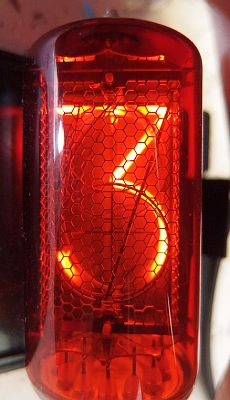I’m planning to use 4 Nixies for this clock build. A 6 tubes build, besides showing the seconds, only offers the advantage of displaying the complete date in one go (DD-MM-YY or MM-DD-YY).
The latter can be accomplished if we split the date display in two (DD-MM then YYYY).
So how, many digits do I need to drive ?
Well, if we want to have all the digits available to us, this means 4 tubes times 10 digits equals 40 independent digits. Now for a specific clock build, the actual need is lower :
If we name each Nixie tube of the clock N1, N2, N3 and N4, then :
For a HH:MM time format, HH will be maximum 23, and MM 59, so for each Nixie :
- N1 can only be 0, 1, or 2 (total of 3 digits, for 24hrs display)
- N2 can be any digits from 0 to 9 (10 digits)
- N3 can only be digits from 0 to 5 ( 6 digits)
- N4 can be any digits from 0 to 9 (10 digits)
That lowers our need to 29 digits to be driven for the time display only.
For a DD-MM date format display DD will be maximum 31 and MM 12 :
- N1 needs to be able to display digit 3 as well as digits 0, 1, 2 mentioned above.
A MM-DD date format is already covered by previous digits selection.
So far we have :
- N1 = [0 - 3]
- N2 = [0 - 9]
- N3 = [0 - 5]
- N4 = [0 - 9]
For a total of 30 independent digits.
This allows to also cover a YYYY year display, with the following limitation :
We can display all years until 2059 then N3 is limiting the decades value to show. Ideally if we want to display year xx99, then N3 should contains all digits from 0 to 9 but this would bring our total digits required to 34.
Unfortunately the driver I’m planning to use only drives a maximum of 32 outputs (32 bits), therefore if we have N3 connected to digits 6 and 7 then we have a total of 32 digits driven and covers the years display up to 2079.
This is good enough for me, and I’d be quite happy if the clock lasts until then. After this date, in theory all would still function except the year display, which would only be available again in year 2100+. After all is this really important ?
One drawback of this is that some cathodes will never be lit as they are not connected. Those cathodes will be subject to cathode poisoning and may deteriorate over time.

To prevent this, if all cathodes were connected, one can code a cathode preservation routine, which would switch on all digits one after another in order to keep the wear of the whole tube equal and prevent unused cathodes to become contaminated.
In my case, the only way to prevent cathode poisoning would be to manually swap the tubes 2 by 2 every now and then (not sure about the frequency, but every year should do I guess). Tubes should therefore be connected to the PCB through pin sockets in order to be easily removed.
 Frederic L
Frederic L
Discussions
Become a Hackaday.io Member
Create an account to leave a comment. Already have an account? Log In.